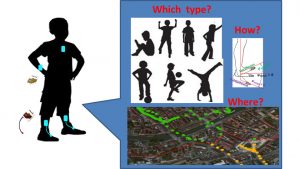- Contact person: Anisoara Ionescu
- People involved: Anisora Ionescu, Lena Carcreff
- Partners:
- Funding source:
Overview
Physical activity behavior in every-day life is multidimensional characterized by type (posture allocation, locomotion, activities of daily living), intensity (walking speed, body acceleration), duration (activity bouts), frequency (postural transitions, activity bouts in a time-frame), patterns (temporal organization of various movements and activities), context (circumstances under which physical activity is performed) and quality of body movements (duration of postural transition, gait coordination, etc.). Multimodal wearable sensors integrating inertial, GPS, barometric pressure, temperature sensing and placed on multiple body segments allow a comprehensive assessment providing information about which, how many, how and where the various activities and body movements are performed.
Cerebral Palsy
Cerebral palsy (CP) is the most frequent motor disorder in childhood with a neonatal prevalence of 2:1000 live births. Two thirds of children with CP achieve community ambulation and independent walking is at the forefront of therapeutic objectives for children with CP who present this motor potential. Clinicians require a comprehensive and objective evaluation of movement impairments, their possible causes and consequences on daily life, first to establish treatment strategies but also to adequately monitor the outcomes of these treatments. The objective of the project is to design a wearable system based on multi-sensing miniaturized devices and algorithms to provide a set of metrics that are clinically useful, interpretable and related to movement, physical activity and lifestyle features.
